Lead Pollution, Demographics, and Environmental Health Risks: The Case of Philadelphia, USA
Abstract
:1. Introduction
2. Materials and Methods
2.1. Soil Samples
2.2. Data Availability
2.3. Geospatial Mapping and Statistical Analyses
2.4. Lead Index
3. Results
4. Discussion
5. Conclusions
Supplementary Materials
Author Contributions
Funding
Institutional Review Board Statement
Informed Consent Statement
Data Availability Statement
Acknowledgments
Conflicts of Interest
References
- Varrica, D.; Dongarrà, G.; Sabatino, G.; Monna, F. Inorganic geochemistry of roadway dust from the metropolitan area of Palermo, Italy. Environ. Geol. 2003, 44, 222–230. [Google Scholar] [CrossRef]
- Lu, X.; Wang, L.; Li, L.Y.; Lei, K.; Huang, L.; Kang, D. Multivariate statistical analysis of heavy metals in street dust of Baoji, NW China. J. Hazard. Mater. 2010, 173, 744–749. [Google Scholar] [CrossRef] [PubMed]
- Kabadayi, F.; Cesur, H. Determination of Cu, Pb, Zn, Ni, Co, Cd, and Mn in road dusts of Samsun City. Environ. Monit. Assess. 2010, 168, 241–253. [Google Scholar] [CrossRef] [PubMed]
- Han, X.; Lu, X.; Qinggeletu; Wu, Y. Health risks and contamination levels of heavy metals in dusts from parks and squares of an industrial city in semi-arid area of China. Int. J. Environ. Res. Public Health 2017, 14, 886. [Google Scholar] [CrossRef] [Green Version]
- Ordóñez, A.; Loredo, J.; De Miguel, E.; Charlesworth, S. Distribution of heavy metals in the street dusts and soils of an industrial city in Northern Spain. Arch. Environ. Contam. Toxicol. 2003, 44, 160–170. [Google Scholar] [CrossRef]
- Lusby, G.; Hall, C.; Reiners, J. Lead Contamination of Surface Soils in Philadelphia from Lead Smelters and Urbanization. Environ. Justice 2015, 8, 6–14. [Google Scholar] [CrossRef]
- Miler, M.; Gosar, M. Chemical and morphological characteristics of solid metal-bearing phases deposited in snow and stream sediment as indicators of their origin. Environ. Sci. Pollut. Res. 2015, 22, 1906–1918. [Google Scholar] [CrossRef] [PubMed]
- Trujillo-González, J.M.; Torres-Mora, M.A.; Keesstra, S.; Brevik, E.C.; Jiménez-Ballesta, R. Heavy metal accumulation related to population density in road dust samples taken from urban sites under different land uses. Sci. Total Environ. 2016, 553, 636–642. [Google Scholar] [CrossRef]
- Legalley, E.; Krekeler, M.P.S. A mineralogical and geochemical investigation of street sediment near a coal-fired power plant in Hamilton, Ohio: An example of complex pollution and cause for community health concerns. Environ. Pollut. 2013, 176, 26–35. [Google Scholar] [CrossRef]
- White, K.; Detherage, T.; Verellen, M.; Tully, J.; Krekeler, M.P.S. An investigation of lead chromate (crocoite-PbCrO4) and other inorganic pigments in aged traffic paint samples from Hamilton, Ohio: Implications for lead in the environment. Environ. Earth Sci. 2014, 71, 3517–3528. [Google Scholar] [CrossRef]
- Walraven, N.; Bakker, M.; Van Os, B.J.H.; Klaver, G.T.; Middelburg, J.J.; Davies, G.R. Factors controlling the oral bioaccessibility of anthropogenic Pb in polluted soils. Sci. Total Environ. 2015, 506–507, 149–163. [Google Scholar] [CrossRef] [PubMed]
- Padoan, E.; Romè, C.; Ajmone-Marsan, F. Bioaccessibility and size distribution of metals in road dust and roadside soils along a peri-urban transect. Sci. Total Environ. 2017, 601–602, 89–98. [Google Scholar] [CrossRef] [PubMed]
- Dean, J.R.; Elom, N.I.; Entwistle, J.A. Use of simulated epithelial lung fluid in assessing the human health risk of Pb in urban street dust. Sci. Total Environ. 2017, 579, 387–395. [Google Scholar] [CrossRef] [PubMed]
- O’Shea, M.J.; Vann, D.R.; Hwang, W.T.; Gieré, R. A mineralogical and chemical investigation of road dust in Philadelphia, PA, USA. Environ. Sci. Pollut. Res. 2020, 27, 14883–14902. [Google Scholar] [CrossRef] [PubMed]
- O’Shea, M.J.; Vigliaturo, R.; Choi, J.K.; McKeon, T.P.; Krekeler, M.P.S.; Gieré, R. Alteration of yellow traffic paint in simulated environmental and biological fluids. Sci. Total Environ. 2021, 750, 141202. [Google Scholar] [CrossRef] [PubMed]
- Dietrich, M.; Krekeler, M.P.S.; Kousehlar, M.; Widom, E. Quantification of Pb pollution sources in complex urban environments through a multi-source isotope mixing model based on Pb isotopes in lichens and road sediment. Environ. Pollut. 2021, 288, 117815. [Google Scholar] [CrossRef]
- Kelepertzis, E.; Argyraki, A.; Chrastný, V.; Botsou, F.; Skordas, K.; Komárek, M.; Fouskas, A. Metal(loid) and isotopic tracing of Pb in soils, road and house dusts from the industrial area of Volos (central Greece). Sci. Total Environ. 2020, 725, 138300. [Google Scholar] [CrossRef]
- Kelepertzis, E.; Chrastn, V.; Botsou, F.; Sigala, E.; Kypritidou, Z.; Komárek, M.; Skordas, K.; Argyraki, A. Science of the Total Environment Tracing the sources of bioaccessible metal ( loid ) s in urban environments: A multidisciplinary approach. Sci. Total Environ. 2021, 771, 144827. [Google Scholar] [CrossRef]
- Christoforidis, A.; Stamatis, N. Heavy metal contamination in street dust and roadside soil along the major national road in Kavala’s region, Greece. Geoderma 2009, 151, 257–263. [Google Scholar] [CrossRef]
- Wei, B.; Yang, L. A review of heavy metal contaminations in urban soils, urban road dusts and agricultural soils from China. Microchem. J. 2010, 94, 99–107. [Google Scholar] [CrossRef]
- Apeagyei, E.; Bank, M.S.; Spengler, J.D. Distribution of heavy metals in road dust along an urban-rural gradient in Massachusetts. Atmos. Environ. 2011, 45, 2310–2323. [Google Scholar] [CrossRef]
- Gunawardana, C.; Goonetilleke, A.; Egodawatta, P.; Dawes, L.; Kokot, S. Source characterisation of road dust based on chemical and mineralogical composition. Chemosphere 2012, 87, 163–170. [Google Scholar] [CrossRef] [Green Version]
- Dietrich, M.; Huling, J.; Krekeler, M.P.S. Metal pollution investigation of Goldman Park, Middletown Ohio: Evidence for steel and coal pollution in a high child use setting. Sci. Total Environ. 2018, 618, 1350–1362. [Google Scholar] [CrossRef]
- Gaberšek, M.; Gosar, M. Geochemistry of urban soil in the industrial town of Maribor, Slovenia. J. Geochem. Explor. 2018, 187, 141–154. [Google Scholar] [CrossRef]
- Teran, K.; Žibret, G.; Fanetti, M. Impact of urbanization and steel mill emissions on elemental composition of street dust and corresponding particle characterization. J. Hazard. Mater. 2020, 384, 120963. [Google Scholar] [CrossRef] [PubMed]
- O’Shea, M.J.; Krekeler, M.P.; Vann, D.R.; Gieré, R. Investigation of Pb-Contaminated soil and road dust in a polluted area of Philadelphia. Environ. Monit. Assess. 2021, 193, 440. [Google Scholar] [CrossRef] [PubMed]
- Gaberšek, M.; Gosar, M. Towards a holistic approach to the geochemistry of solid inorganic particles in the urban environment. Sci. Total Environ. 2021, 763, 144214. [Google Scholar] [CrossRef] [PubMed]
- Duzgoren-Aydin, N.S.; Wong, C.S.C.; Aydin, A.; Song, Z.; You, M.; Li, X.D. Heavy Metal Contamination and Distribution in the Urban Environment of Guangzhou, SE China. Environ. Geochem. Health 2006, 28, 375–391. [Google Scholar] [CrossRef] [PubMed]
- Laidlaw, M.A.S.; Mielke, H.W.; Filippelli, G.M.; Johnson, D.L.; Gonzales, C.R. Seasonality and children’s blood lead levels: Developing a predictive model using climatic variables and blood lead data from Indianapolis, Indiana, Syracuse, New York, and New Orleans, Louisiana (USA). Environ. Health Perspect. 2005, 113, 793–800. [Google Scholar] [CrossRef] [Green Version]
- Schachter, A.E.; Gailey, A.; Egendorf, S.P.; Mielke, H.W. Mechanisms of children’s soil exposure. Curr. Probl. Pediatr. Adolesc. Health Care 2020, 50, 100742. [Google Scholar] [CrossRef]
- Resongles, E.; Dietze, V.; Green, D.C.; Harrison, R.M.; Ochoa-gonzalez, R.; Tremper, A.H.; Weiss, D. Strong evidence for the continued contribution of lead deposited during the 20th century to the atmospheric environment in London of today. Proc. Natl. Acad. Sci. USA 2021, 118, e2102791118. [Google Scholar] [CrossRef]
- Hansson, S.V.; Grusson, Y.; Chimienti, M.; Claustres, A.; Jean, S.; Le Roux, G. Legacy Pb pollution in the contemporary environment and its potential bioavailability in three mountain catchments. Sci. Total Environ. 2019, 671, 1227–1236. [Google Scholar] [CrossRef]
- Smith, D.; Cannon, W.; Woodruff, L.; Solano, F.; Ellefsen, K. Geochemical and Mineralogic Maps of Soils of the Conterminous United States; USGS Open-File Report; USGS: Reston, VA, USA, 2014; p. 1082. [Google Scholar]
- USEPA. USGS Background Soil-Lead Survey: State Data. Available online: https://www.epa.gov/superfund/usgs-background-soil-lead-survey-state-data (accessed on 12 August 2021).
- Frank, J.J.; Poulakos, A.G.; Tornero-Velez, R.; Xue, J. Systematic review and meta-analyses of lead (Pb) concentrations in environmental media (soil, dust, water, food, and air) reported in the United States from 1996 to 2016. Sci. Total Environ. 2019, 694, 133489. [Google Scholar] [CrossRef] [PubMed]
- Lanphear, B.P.; Matte, T.D.; Rogers, J.; Clickner, R.P.; Dietz, B.; Bornschein, R.L.; Succop, P.; Mahaffey, K.R.; Dixon, S.; Galke, W.; et al. The contribution of lead-contaminated house dust and residential soil to children’s blood lead levels: A pooled analysis of 12 epidemiologic studies. Environ. Res. 1998, 79, 51–68. [Google Scholar] [CrossRef] [Green Version]
- Mielke, H.W.; Reagan, P.L. Soil is an important pathway of human lead exposure. Environ. Health Perspect. 1998, 106, 217–229. [Google Scholar] [CrossRef] [Green Version]
- Johnson, D.L.; Bretsch, J.K. Soil Lead and Children’s Blood Lead Levels. Environ. Geochem. Health 2002, 24, 375–385. [Google Scholar] [CrossRef]
- Levin, R.; Brown, M.J.; Kashtock, M.E.; Jacobs, D.E.; Whelan, E.A.; Rodman, J.; Schock, M.R.; Padilla, A.; Sinks, T. Lead exposures in U.S. children, 2008: Implications for prevention. Environ. Health Perspect. 2008, 116, 1285–1293. [Google Scholar] [CrossRef] [Green Version]
- Anttila, A.; Heikkila, P.; Pukkala, E.; Nykyri, E.; Kauppinen, T.; Hernberg, S.; Hemminki, K. Excess lung cancer among workers exposed to lead. Scand. J. Work. Environ. Health 1995, 21, 460–469. [Google Scholar] [CrossRef] [PubMed]
- Alatise, O.I.; Schrauzer, G.N. Lead exposure: A contributing cause of the current breast cancer epidemic in Nigerian Women. Biol. Trace Elem. Res. 2010, 136, 127–139. [Google Scholar] [CrossRef] [PubMed] [Green Version]
- Agency for Toxic Substance and Disease Registry. ATSDR Substance Priority List; ATSDR: Atlanta, GA, USA, 2019. [Google Scholar]
- WHO. Lead Poisoning and Health; WHO: Geneva, Switzerland, 2019; Available online: https://www.who.int/news-room/fact-sheets/detail/lead-poisoning-and-health (accessed on 2 October 2020).
- Al-Rajhi, M.A.; Seaward, M.R.D.; Al-Aamer, A.S. Metal levels in indoor and outdoor dust in Riyadh, Saudi Arabia. Environ. Int. 1996, 22, 315–324. [Google Scholar] [CrossRef]
- Lanphear, B.P.; Hornung, R.; Khoury, J.; Yolton, K.; Baghurst, P.; Bellinger, D.C.; Canfield, R.L.; Dietrich, K.N.; Bornschein, R.; Greene, T.; et al. Low-level environmental lead exposure and children’s intellectual function: An international pooled analysis. Environ. Health Perspect. 2005, 113, 894–899. [Google Scholar] [CrossRef]
- Center for Disease Control and Prevention. CDC National Childhood Blood Lead Surveillance Data. Available online: https://www.cdc.gov/nceh/lead/data/national.htm (accessed on 12 August 2021).
- City of Philadelphia, Department of Public Health. Childhood Lead Poisoning Surveillance Report 2018; Philadelphia Department of Public Health: Philadelphia, PA, USA, 2019. [Google Scholar]
- Benfer, E.A. Contaminated childhood: How the United States failed to prevent the chronic lead poisoning of low-income children and communities of color. Harv. Environ. Law Rev. 2017, 41, 563–596. [Google Scholar]
- Jones, R.L.; Homa, D.M.; Meyer, P.A.; Brody, D.J.; Caldwell, K.L.; Pirkle, J.L.; Brown, M.J. Trends in blood lead levels and blood lead testing among US children aged 1 to 5 years, 1988–2004. Pediatrics 2009, 123, e376–e385. [Google Scholar] [CrossRef] [Green Version]
- Pirkle, J.L. The Decline in Blood Lead Levels in the United States. JAMA 1994, 272, 284. [Google Scholar] [CrossRef]
- Aelion, C.M.; Davis, H.T.; Lawson, A.B.; Cai, B.; McDermott, S. Associations between soil lead concentrations and populations by race/ethnicity and income-to-poverty ratio in urban and rural areas. Environ. Geochem. Health 2013, 35, 1–12. [Google Scholar] [CrossRef] [Green Version]
- Yeter, D.; Banks, E.C.; Aschner, M. Disparity in risk factor severity for early childhood blood lead among predominantly African-American black children: The 1999 to 2010 US NHANES. Int. J. Environ. Res. Public Health 2020, 17, 1552. [Google Scholar] [CrossRef] [Green Version]
- Kim, D.; Galeano, M.A.O.; Hull, A.; Miranda, M.L. A framework for widespread replication of a highly spatially resolved childhood lead exposure risk model. Environ. Health Perspect. 2008, 116, 1735–1739. [Google Scholar] [CrossRef] [Green Version]
- Kaplowitz, S.A.; Perlstadt, H.; Post, L.A. Comparing lead poisoning risk assessment methods: Census block group characteristics vs. zip codes as predictors. Public Health Rep. 2010, 125, 234–245. [Google Scholar] [CrossRef] [PubMed]
- Vaidyanathan, A.; Staley, F.; Shire, J.; Muthukumar, S.; Kennedy, C.; Meyer, P.A.; Brown, M.J. Screening for Lead Poisoning: A Geospatial Approach to Determine Testing of Children in At-Risk Neighborhoods. J. Pediatr. 2009, 154, 409–414. [Google Scholar] [CrossRef] [PubMed]
- Mielke, H.W.; Dugas, D.; Mielke, P.W.; Smith, K.S.; Smith, S.L.; Gonzales, C.R. Associations between soil lead and childhood blood lead in urban New Orleans and rural Lafourche Parish of Louisiana. Environ. Health Perspect. 1997, 105, 950–954. [Google Scholar] [CrossRef] [PubMed]
- Griffith, D.A.; Doyle, P.G.; Wheeler, D.C.; Johnson, D.L. A tale of two swaths: Urban childhood blood-lead levels across Syracuse, New York. Ann. Assoc. Am. Geogr. 1998, 88, 640–665. [Google Scholar] [CrossRef]
- Hanchette, C.L. The political ecology of lead poisoning in eastern North Carolina. Health Place 2008, 14, 209–216. [Google Scholar] [CrossRef]
- Haley, V.B.; Talbot, T.O. Geographic analysis of blood lead levels in New York State children born 1994–1997. Environ. Health Perspect. 2004, 112, 1577–1582. [Google Scholar] [CrossRef] [Green Version]
- Miranda, M.L.; Dolinoy, D.C. Using GIS-based approaches to support research on neurotoxicants and other children’s environmental health threats. Neurotoxicology 2005, 26, 223–228. [Google Scholar] [CrossRef]
- Oyana, T.J.; Margai, F.M. Spatial patterns and health disparities in pediatric lead exposure in Chicago: Characteristics and profiles of high-risk neighborhoods. Prof. Geogr. 2010, 62, 46–65. [Google Scholar] [CrossRef]
- Pavilonis, B.; Maroko, A.; Cheng, Z. Lead in New York City’s soils: Population growth, land use, and contamination. Int. J. Hyg. Environ. Health 2020, 229, 113564. [Google Scholar] [CrossRef] [PubMed]
- Dignam, T.; Pomales, A.; Werner, L.; Newbern, E.C.; Hodge, J.; Nielsen, J.; Grober, A.; Scruton, K.; Young, R.; Kelly, J.; et al. Assessment of Child Lead Exposure in a Philadelphia Community, 2014. J. Public Health Manag. Pract. 2019, 25, 53–61. [Google Scholar] [CrossRef] [PubMed]
- Mehta, N.; Cocerva, T.; Cipullo, S.; Padoan, E.; Dino, G.A.; Ajmone-Marsan, F.; Cox, S.F.; Coulon, F.; De Luca, D.A. Linking oral bioaccessibility and solid phase distribution of potentially toxic elements in extractive waste and soil from an abandoned mine site: Case study in Campello Monti, NW Italy. Sci. Total Environ. 2019, 651, 2799–2810. [Google Scholar] [CrossRef] [Green Version]
- Weiss, J. Wissahickon Schist At Philadelphia, Pennsylvania. Bull. Geol. Soc. Am. 1949, 60, 1689–1726. [Google Scholar] [CrossRef]
- Eisen, L.; Eisen, R.J. Benefits and drawbacks of citizen science to complement traditional data gathering approaches for medically important hard ticks (Acari: Ixodidae) in the United States. J. Med. Entomol. 2021, 58, 1–9. [Google Scholar] [CrossRef]
- Geolytics Inc. Annual Estimate, Professional, Single State (PA); Geolytics Inc: East Brunswick, NJ, USA, 2014. [Google Scholar]
- United States Zipcodes Year Housing Was Built. Available online: https://www.unitedstateszipcodes.org/ (accessed on 21 June 2020).
- City of Philadelphia, Department of Licences and Inspection. Building Demolitions. Available online: https://www.opendataphilly.org/dataset/building-demolitions (accessed on 8 January 2021).
- USEPA Sites with Potential Smelting-Related Operations (FOIA 1). Available online: https://www.epa.gov/superfund/superfund-data-and-reports (accessed on 10 August 2020).
- Eckel, W.P.; Rabinowitz, M.B.; Foster, G.D. Discovering unrecognized lead-smelting sites by historical methods. Am. J. Public Health 2001, 91, 625–627. [Google Scholar] [CrossRef] [PubMed] [Green Version]
- Murphey, D.; Epstein, D.; Shaw, S.; McDaniel, T.; Steber, K. The Status of Infants and Toddlers in Philadelphia; Child Trends: Bethesda, MD, USA, 2018. [Google Scholar]
- City of Philadelphia, Department of Planning and Development. Land Use. Available online: https://www.opendataphilly.org/dataset/land-use (accessed on 8 August 2020).
- Flett, L.; Krekeler, M.P.S.; Burke, M. Investigations of road sediment in an industrial corridor near low-income housing in Hamilton, Ohio. Environ. Earth Sci. 2016, 75, 1156. [Google Scholar] [CrossRef]
- Reyes, A.; Thiombane, M.; Panico, A.; Daniele, L.; Lima, A.; Di Bonito, M.; De Vivo, B. Source patterns of potentially toxic elements (PTEs) and mining activity contamination level in soils of Taltal city (northern Chile). Environ. Geochem. Health 2020, 42, 2573–2594. [Google Scholar] [CrossRef]
- Jadoon, S.; Muhammad, S.; Hilal, Z.; Ali, M.; Khan, S.; Khattak, N.U. Spatial distribution of potentially toxic elements in urban soils of Abbottabad city, (N Pakistan): Evaluation for potential risk. Microchem. J. 2020, 153, 104489. [Google Scholar] [CrossRef]
- Tepanosyan, G.; Sahakyan, L.; Zhang, C.; Saghatelyan, A. The application of Local Moran’s I to identify spatial clusters and hot spots of Pb, Mo and Ti in urban soils of Yerevan. Appl. Geochem. 2019, 104, 116–123. [Google Scholar] [CrossRef]
- Filippelli, G.; Anenberg, S.; Taylor, M.; Geen, A.; Khreis, H. New Approaches to Identifying and Reducing the Global Burden of Disease From Pollution. GeoHealth 2020, 4, e2018GH000167. [Google Scholar] [CrossRef] [PubMed] [Green Version]
- Taylor, M.P.; Filippelli, G.M.; Entwistle, J.; Ho, K.F. Mapmyenvironment. Available online: https://www.mapmyenvironment.com/ (accessed on 9 September 2020).
- Doyi, I.N.Y.; Isley, C.F.; Soltani, N.S.; Taylor, M.P. Human exposure and risk associated with trace element concentrations in indoor dust from Australian homes. Environ. Int. 2019, 133, 105125. [Google Scholar] [CrossRef] [PubMed]
- CEET Lead Sampling in the Philadelphia Region. Available online: https://ceet.upenn.edu/leadsoilmap/ (accessed on 1 January 2021).
- Wu, J.; Edwards, R.; He, X.; Liu, Z.; Kleinman, M. Spatial analysis of bioavailable soil lead concentrations in Los Angeles, California. Environ. Res. 2010, 110, 309–317. [Google Scholar] [CrossRef]
- Marschner, B.; Welge, P.; Hack, A.; Wittsiepe, J.; Wilhelm, M. Comparison of soil Pb in vitro bioaccessibility and in vivo bioavailability with Pb pools from a sequential soil extraction. Environ. Sci. Technol. 2006, 40, 2812–2818. [Google Scholar] [CrossRef]
- Yan, K.; Dong, Z.; Wijayawardena, M.A.A.; Liu, Y.; Naidu, R.; Semple, K. Measurement of soil lead bioavailability and influence of soil types and properties: A review. Chemosphere 2017, 184, 27–42. [Google Scholar] [CrossRef] [Green Version]
- Maryland, Department of the Environment. Lead (Pb) Soil Screening Update Effective July 1, 2020; Maryland Department of the Environment: Baltimore, MD, USA, 2020. [Google Scholar]
- California Department of Toxic Substances Control (DTSC), Human and Ecological Risk Office (HERO). Human Health Risk Assessment (HHRA) Note Number 3, DTSC-Modified Screening Levels (DTSC-SLs); California Department of Toxic Substances Control: Sacramento, CA, USA, 2020. [Google Scholar]
- Schwarz, K.; Pickett, S.T.A.; Lathrop, R.G.; Weathers, K.C.; Pouyat, R.V.; Cadenasso, M.L. The effects of the urban built environment on the spatial distribution of lead in residential soils. Environ. Pollut. 2012, 163, 32–39. [Google Scholar] [CrossRef]
- Yesilonis, I.D.; Pouyat, R.V.; Neerchal, N.K. Spatial distribution of metals in soils in Baltimore, Maryland: Role of native parent material, proximity to major roads, housing age and screening guidelines. Environ. Pollut. 2008, 156, 723–731. [Google Scholar] [CrossRef]
- The Pew Charitable Trusts. Philadelphia’s Councilmanic Prerogative; The Pew Charitable Trusts: Philadelphia, PA, USA, 2015. [Google Scholar]
- Randall, K. Habits of Housing Policy: The Role of Historical Decision-Making Tendencies in Shaping Contemporary Philadelphia Policy. Master’s Thesis, University of Pennsylvania, Philadelphia, PA, USA, 2019. [Google Scholar]
- Caballero-Gomez, H.; White, H.; Pepino, R.; Giere, R. Spatial Analysis and Lead-Risk of Philadelphia, USA. Bachelor’s Thesis, Haverford College, Haverford, PA, USA, 2021. [Google Scholar]
- National Minority Quality Forum Lead Risk Index. Available online: https://www.nmqf.org/nmqf-indexes/lead-risk-index (accessed on 3 August 2020).
- Obeng-Gyasi, E.; Roostaei, J.; Gibson, J.M. Lead Distribution in Urban Soil in a Medium-Sized City: Household-Scale Analysis. Environ. Sci. Technol. 2021, 55, 3696–3705. [Google Scholar] [CrossRef]
- Crossney, K. Redlining. Available online: https://philadelphiaencyclopedia.org/archive/redlining/ (accessed on 3 January 2021).
- Krieger, N.; Chen, J.T.; Waterman, P.D.; Soobader, M.J.; Subramanian, S.V.; Carson, R. Choosing area based socioeconomic measures to monitor social inequalities in low birth weight and childhood lead poisoning: The public health disparities geocoding project (US). J. Epidemiol. Community Health 2003, 57, 186–199. [Google Scholar] [CrossRef] [Green Version]
- Lynch, E.E.; Meier, H.C.S. The intersectional effect of poverty, home ownership, and racial/ethnic composition on mean childhood blood lead levels in Milwaukee County neighborhoods. PLoS ONE 2020, 15, e0234995. [Google Scholar] [CrossRef]
- Curtis, G.; Braggio, J.; Fokum, F.; Roberts, J.; Scott, R.; Staley, F.; Al, E. Using GIS to Assess and Direct Childhood Lead Poisoning Prevention: Guidance for State and Local Childhood Lead Poisoning Prevention Programs; CDC: Atlanta, GA, USA, 2004. [Google Scholar]

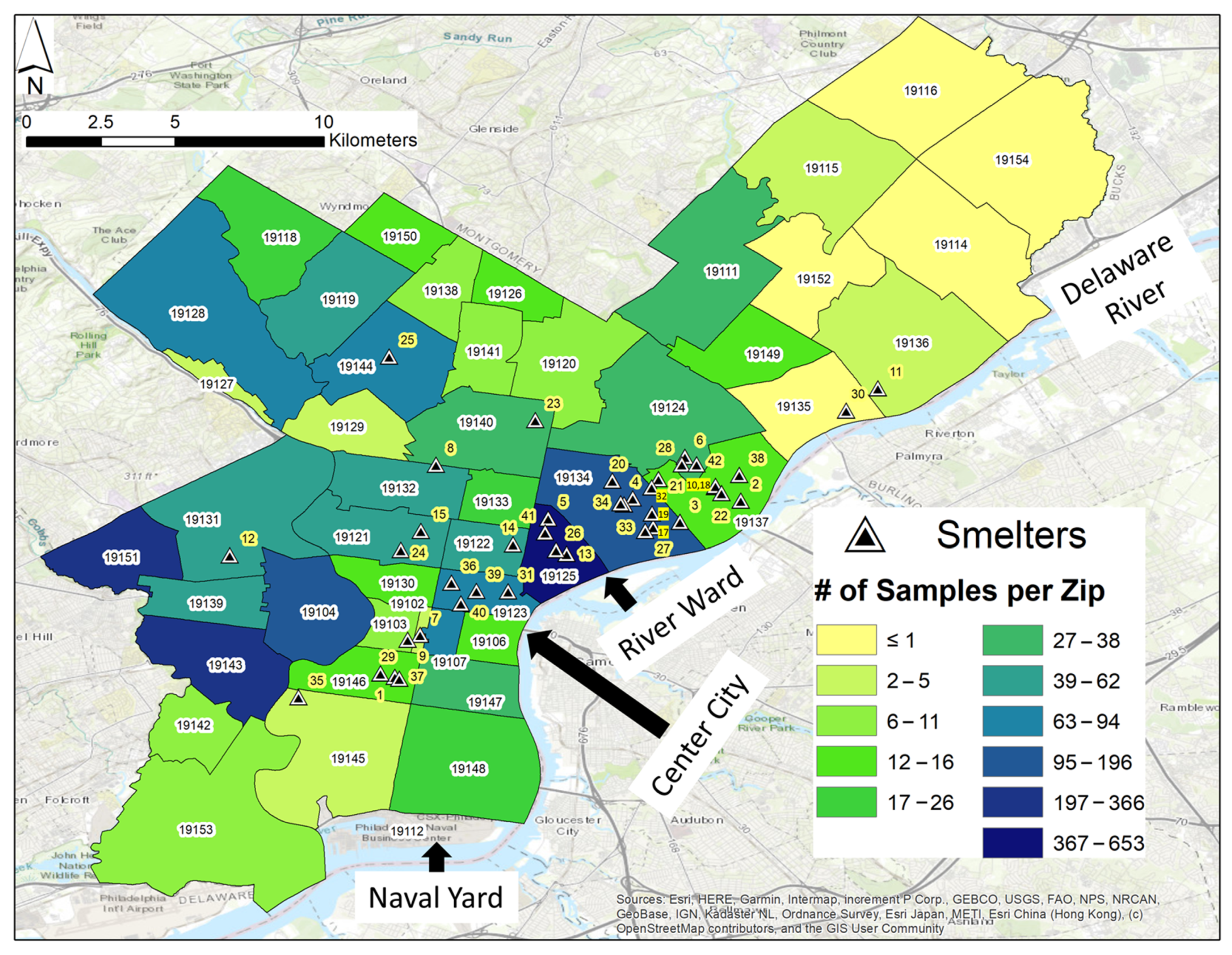
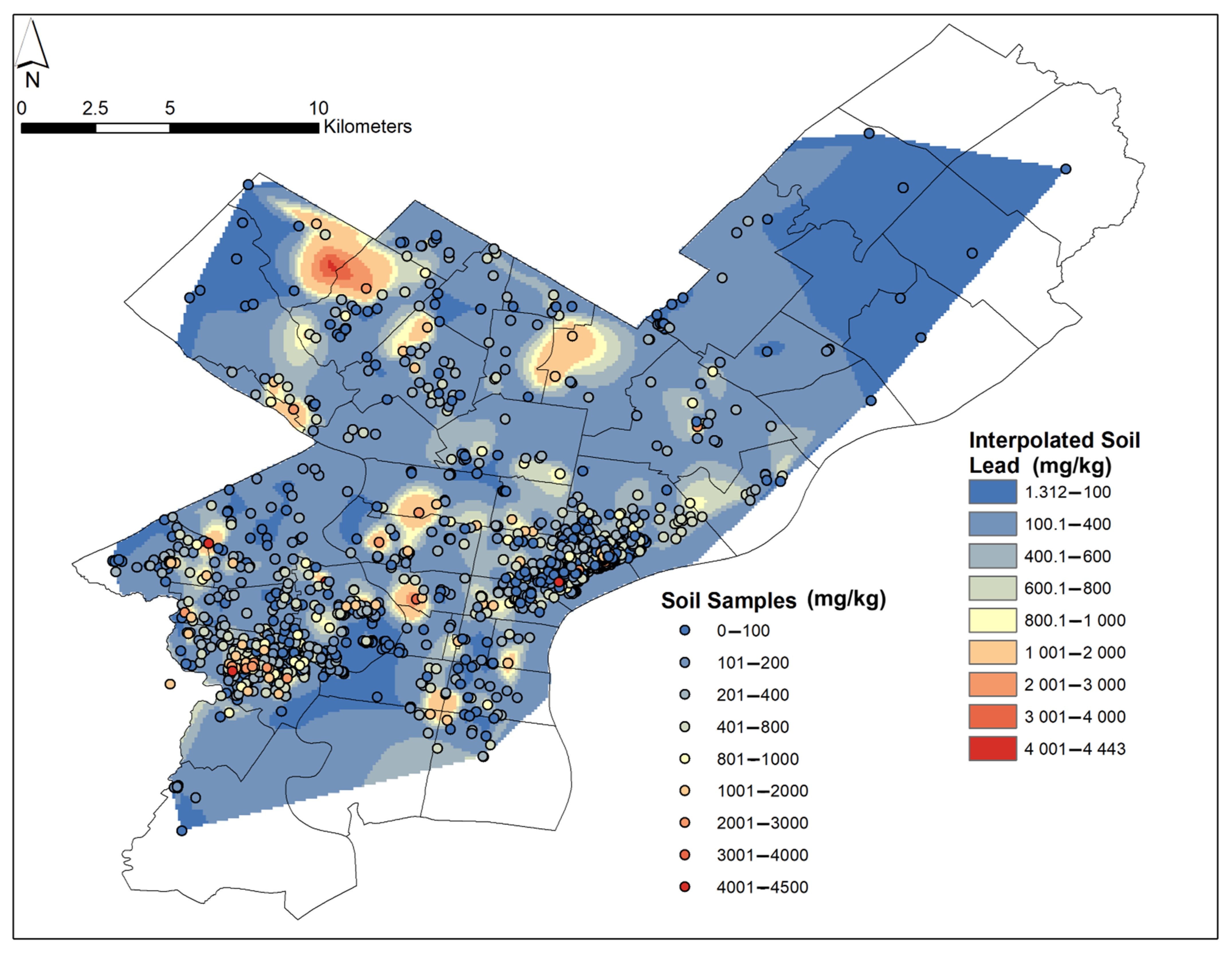
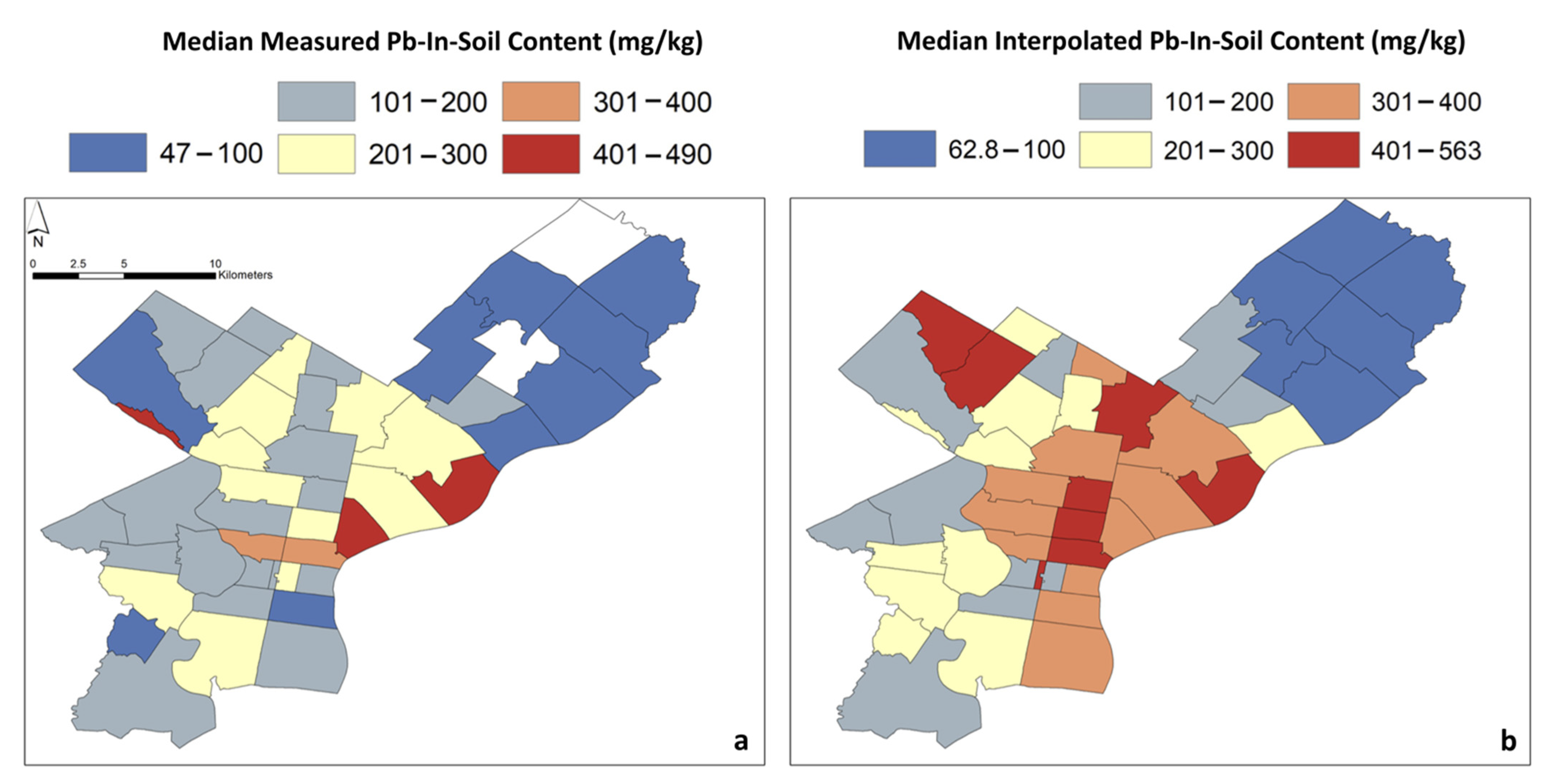
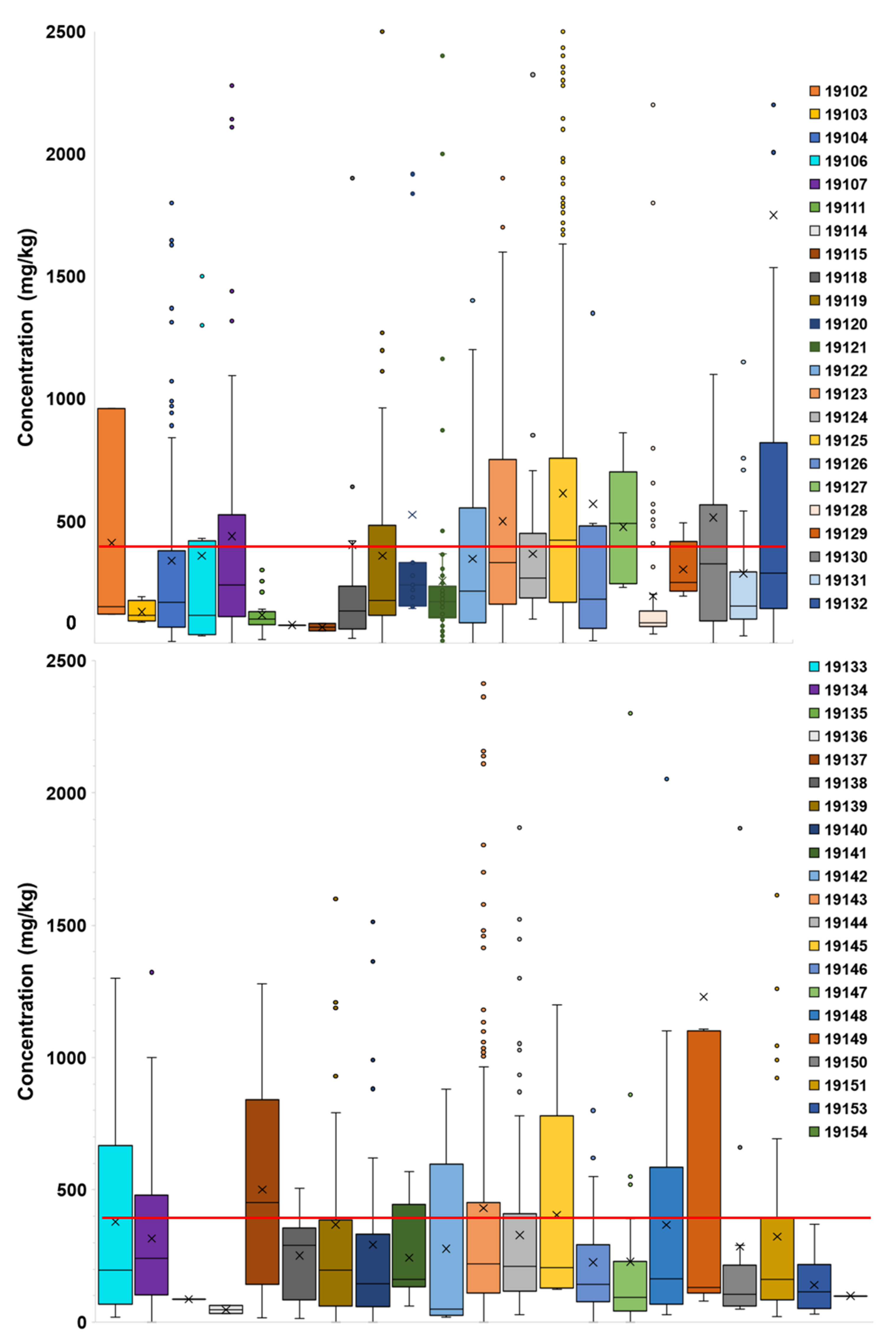
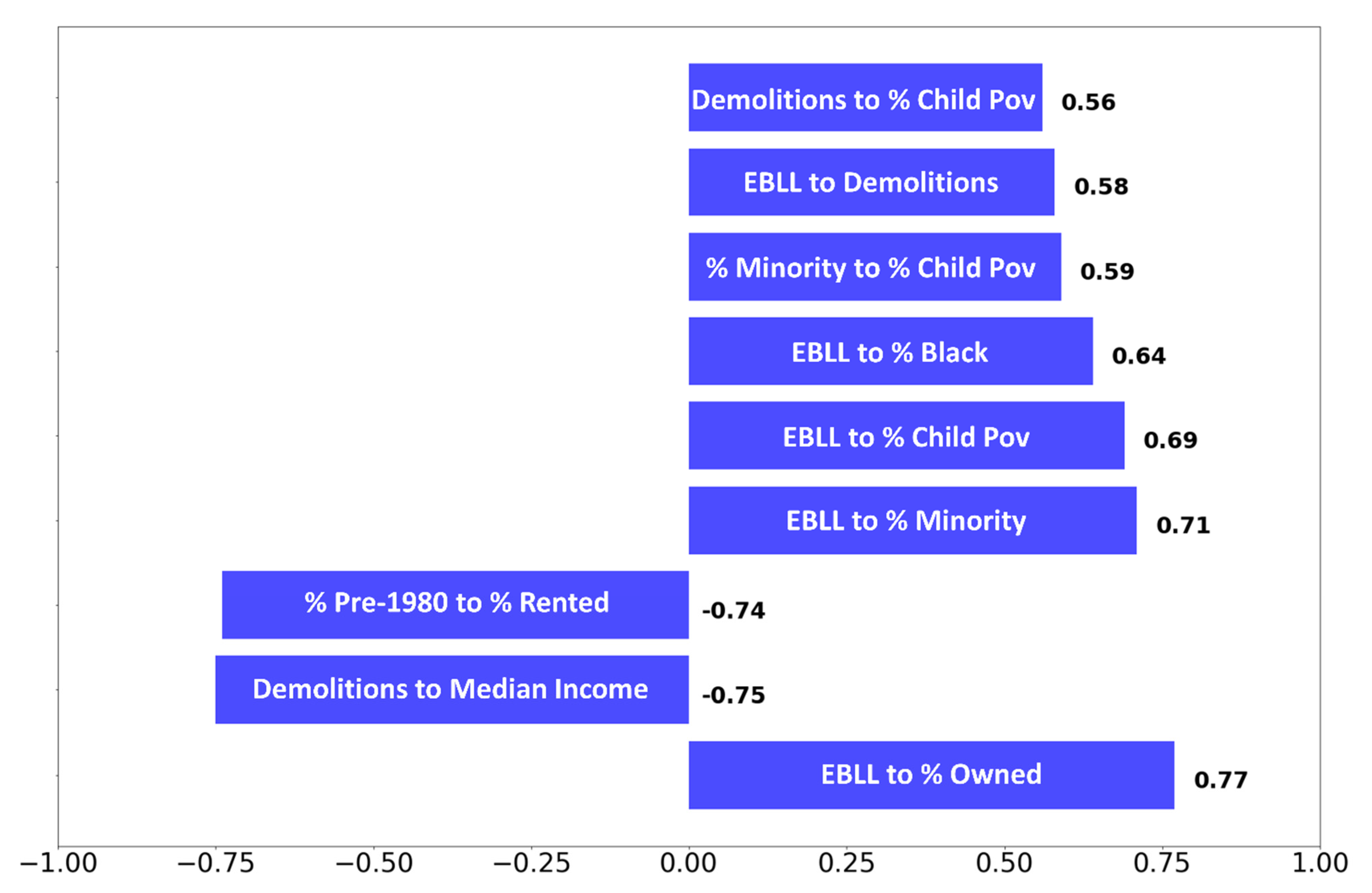
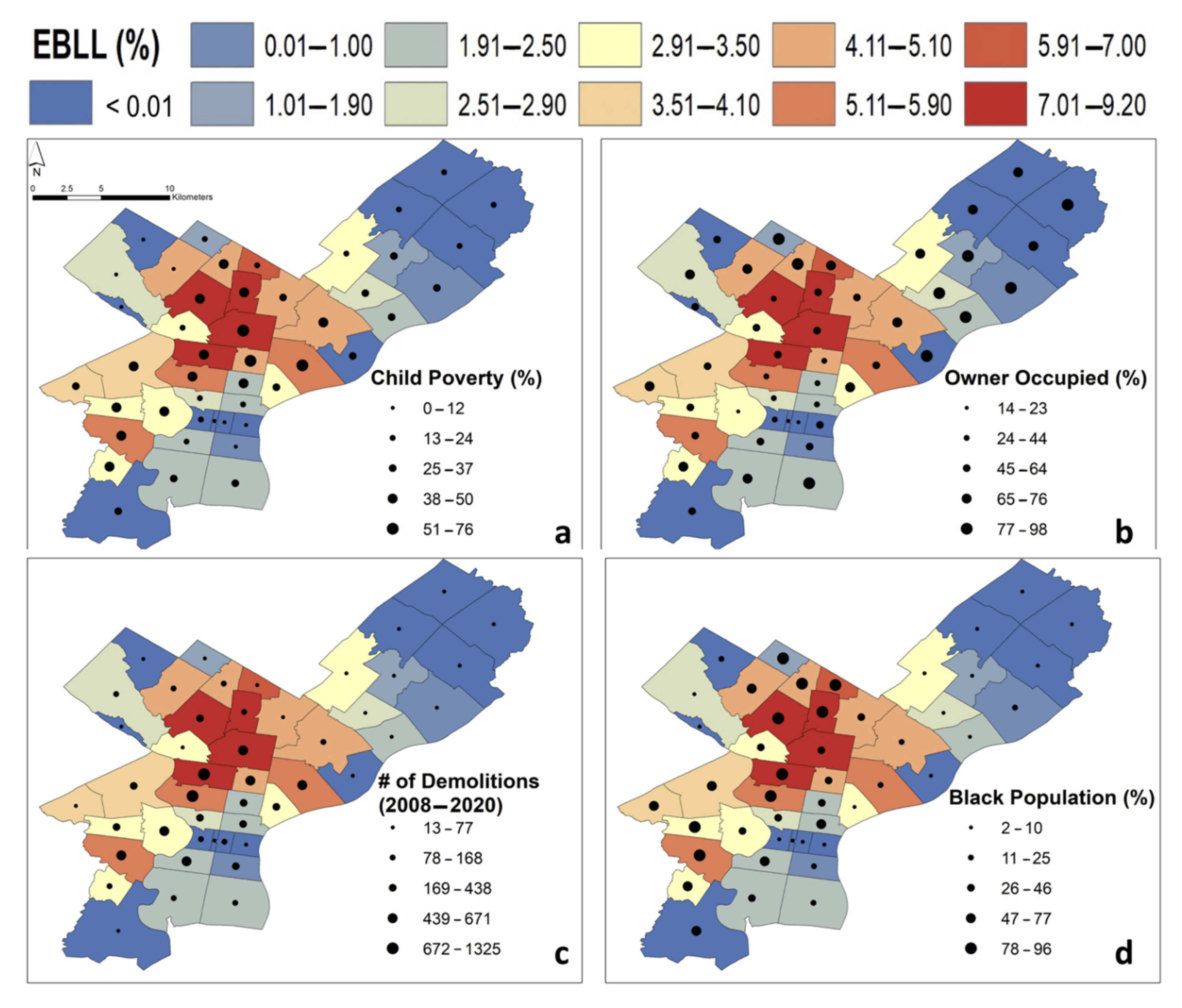
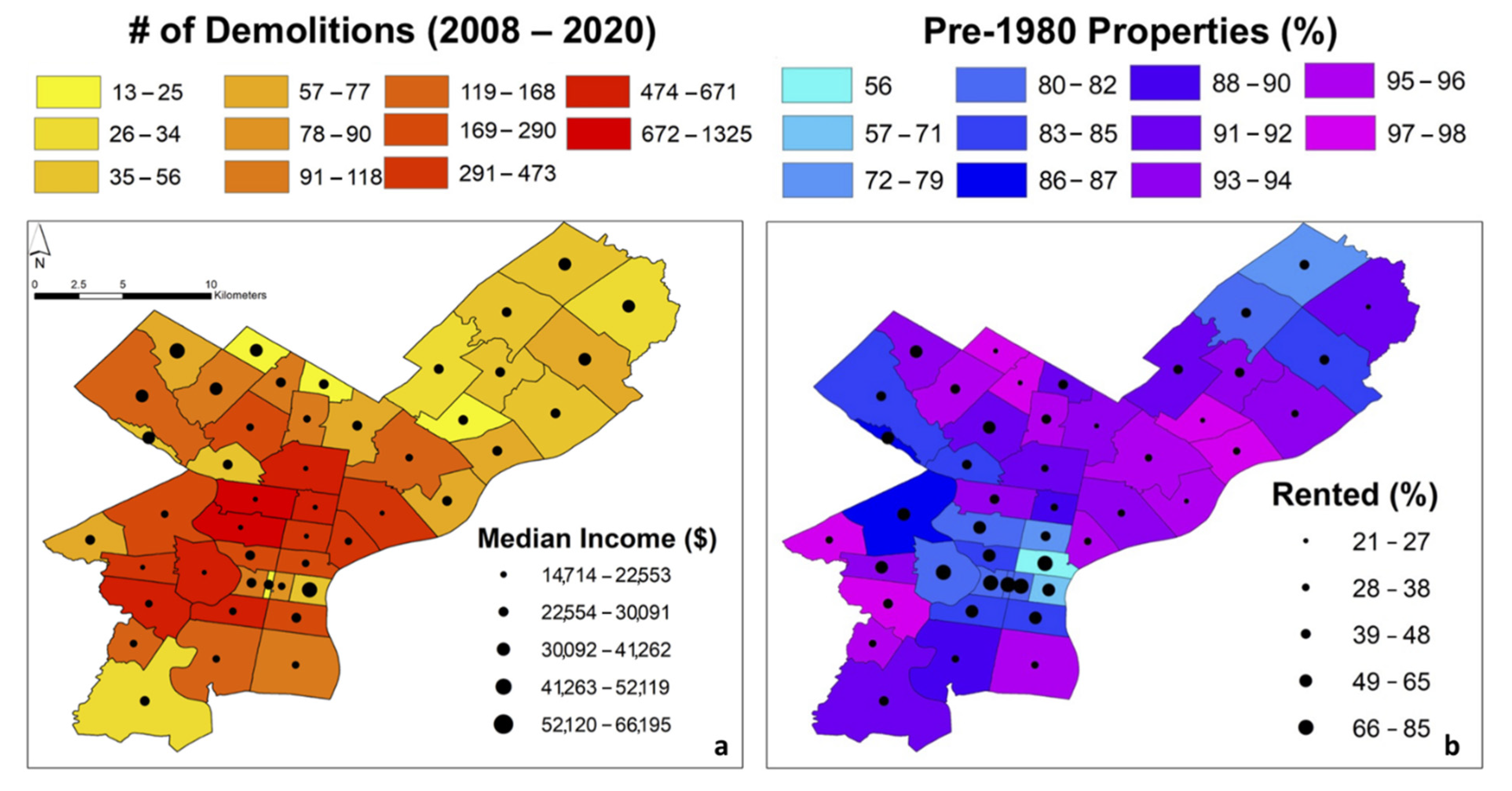
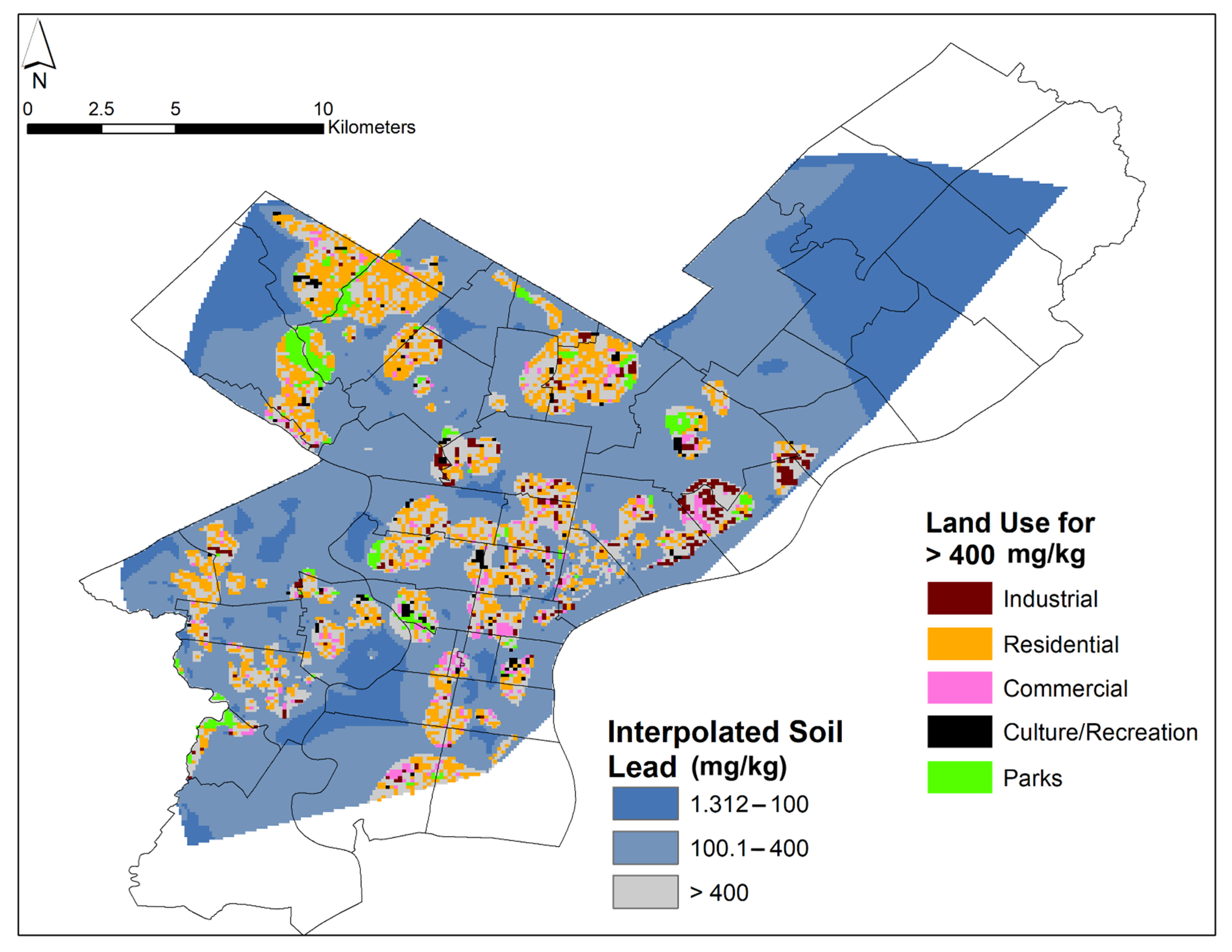
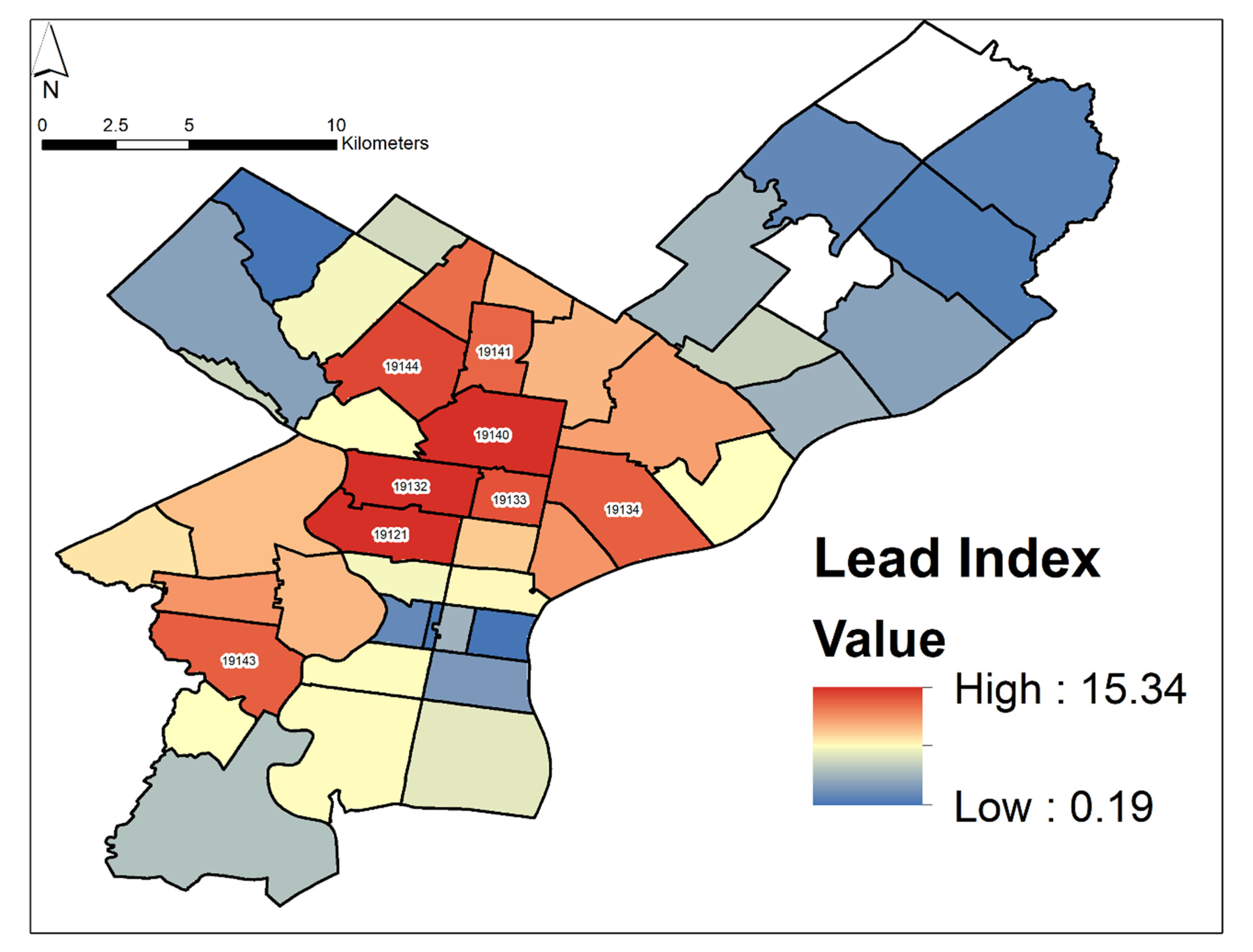
Publisher’s Note: MDPI stays neutral with regard to jurisdictional claims in published maps and institutional affiliations. |
© 2021 by the authors. Licensee MDPI, Basel, Switzerland. This article is an open access article distributed under the terms and conditions of the Creative Commons Attribution (CC BY) license (https://creativecommons.org/licenses/by/4.0/).
Share and Cite
O’Shea, M.J.; Toupal, J.; Caballero-Gómez, H.; McKeon, T.P.; Howarth, M.V.; Pepino, R.; Gieré, R. Lead Pollution, Demographics, and Environmental Health Risks: The Case of Philadelphia, USA. Int. J. Environ. Res. Public Health 2021, 18, 9055. https://doi.org/10.3390/ijerph18179055
O’Shea MJ, Toupal J, Caballero-Gómez H, McKeon TP, Howarth MV, Pepino R, Gieré R. Lead Pollution, Demographics, and Environmental Health Risks: The Case of Philadelphia, USA. International Journal of Environmental Research and Public Health. 2021; 18(17):9055. https://doi.org/10.3390/ijerph18179055
Chicago/Turabian StyleO’Shea, Michael J., Jonas Toupal, Hasibe Caballero-Gómez, Thomas P. McKeon, Marilyn V. Howarth, Richard Pepino, and Reto Gieré. 2021. "Lead Pollution, Demographics, and Environmental Health Risks: The Case of Philadelphia, USA" International Journal of Environmental Research and Public Health 18, no. 17: 9055. https://doi.org/10.3390/ijerph18179055





